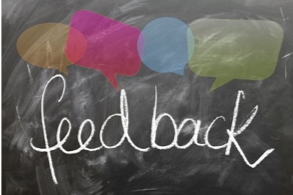This post contributed by Janine Hirtz, Chapter Five Facilitator.

What Kinds of Practice and Feedback Enhance Learning?
WHAT?
Chapter Five of How Learning Works examines the critical role that feedback plays in helping students learn. The principle is that “Goal-directed practice coupled with targeted feedback are critical to learning.”
Practice:
Students need sufficient practice that is focused on a specific goal or set of goals and that is at an appropriate level of challenge.
Feedback Targets:
- What they are understanding or not understanding
- Where they are performing well or where performance is not going very well
- How they should direct subsequent efforts so they can improve
SO WHAT?

(p. 126, Figure 5.1 Cycle of Practice and Feedback)
Characteristics of Effective Feedback:
- Focuses students on the key knowledge and skills you want them to learn
- Is provided in a timely manner and with consistent frequency
- Is linked to additional practice opportunities
NOW WHAT?
Reading this chapter reminded me of an “aha” moment that has guided me in my own work and in my consultations with faculty for the last 14 years. In 2004, in a B.Ed. course, the instructor gave us an assignment with a rubric attached. She asked us to complete the assignment, then grade our own assignment using the attached rubric, including comments, and then hand it all in. The “hand in your own marked rubric method” provides an opportunity for the instructor to comment on the discrepancies between the student’s judgement of their own work and the instructor’s judgment and this helps the student recalibrate.
Later in 2017, at an Scholarship of Teaching and Learning in Higher Ed (STHLE) conference, keynote speaker David Boud, Emeritus Professor from University of Technology in Sydney, Australia, talked about assessment. He challenged us to teach “feedback enabled curriculum” where there are opportunities for feedback early and throughout a course, not just at the end. He shared strategies for creating an environment for “sustainable feedback”—feedback that builds students’ capacity to make judgements about their own learning.
As you read this chapter and reflect on your own teaching practice, or perhaps even, your own experiences as a student, consider the following:
What strategies have you found to be helpful for students to be able to judge their own learning?
Is the type of feedback outlined in this chapter practical in all courses, or for all class sizes?
What about practice? How do we build in practice that is goal-directed so students have an opportunity for improvement?
What do you think about letting students “redo” an assignment?
Post your comments below! To encourage participation, those who share a comment/post this week will have their name entered into the Chapter Five draw for a $25 CAD gift certificate for Chapters Indigo. Read the contest guidelines here. Good luck!
The Book Club chat on Chapter Five will take place on Friday, Oct 26th at 10 AM PST. Check out the schedule and how to connect with the group. We also invite you to say hello in the Comments section of our Intro post.
 Classroom climate is determined by:
Classroom climate is determined by:


